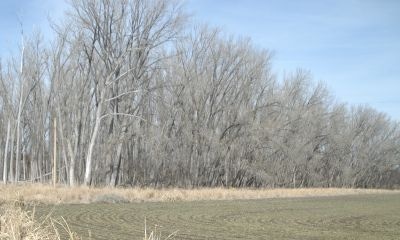
If you have lived in Kansas for any length of time, there are two things you've heard: Wizard of Oz jokes and references to "the" Kansas tree.
Those are jokes of course. The Wizard of Oz was fiction and Kansas forests are reality.
There are 5.2 million acres of forests, woodlands, and trees in Kansas that occupy 10 percent of the state’s total land area. These forests resources can be described as 2.2 million acres of rural forests, 2 million acres of agroforests, which are windbreaks, shelterbelts, streamside forests and fence rows, and 1 million acres of community forests.

Ninety-five percent of the state’s rural forest is privately owned. The remaining five percent is under the ownership and control of public agencies such as the Kansas Department of Wildlife, Parks and Tourism, and the U.S. Department of Defense and Corp. of Engineers.
According to the USDA Forest Service, Kansas’ private forests are owned by 117,000 families and individuals. Sixty-five percent of these owners hold fewer than 10 acres of forestland. Fortunately, however, sixty-five percent of the State’s forest acreage is in ownership sizes of 10 – 99 acres and twenty-five percent in ownerships of more than 100 acres.
The U.S. Forest Stewardship and Kansas Tree Farm programs, work hand in hand to help Kansas farmers and ranchers manage the wooded areas of their lands and encourage them to value those woodlands. The two work together to present the Tree Farmer of the Year Award to collectively recognize a Kansas farmer who has done an exceptional job managing his or her woodlands.
This year's winner is Cal Ammons. On his Butler County tree farm, not far from Towanda, Ammons has demonstrated his love for the land in variety of ways. He has improved the health of his woodlands through thinning operations, which have removed lower quality, invasive species to encourage the growth of more valuable walnut and oak trees. He has planted thousands of trees for a variety of purposes, including a pecan plantation for nut production.
Ammons understands the important function trees provide to stabilize stream banks and improve water quality. In the last three years, he has established four stream bank stabilization projects with forest buffers. As a science teacher, he has repeatedly used his tree farm to lead environmental education sessions and projects to teach young adults the value of forest stewardship.
“My wife and I are honored to receive this award and recognition,” Ammons said. “We have worked this property most of our adult lives. We have continually strived to improve and protect this wonderful resource that we have been blessed with. The stewardship required to preserve and improve a piece of property is a never-ending task. We have made it our life’s work.”
Ammons added that now he and his wife get to share their farm with other people, including those who want to marry in the beautiful outdoors, and with children from Wichita who participate in summer school at the farm. Those opportunities to share the farm with others have been fulfilling.
Working with farmers like Ammons is important to Kansas forest programs because most of the woodlands in Kansas are on private property.
As winner of the 2015 award, Ammons will receive a $100 cash award from the Kansas Forestry Association, an award sign and commemorative plaque.
The awards will be presented at the Fall Forestry Field Day on Saturday, Oct. 17, at the Paul Dean Tree Farm in Madison.
About the Author(s)
You May Also Like






